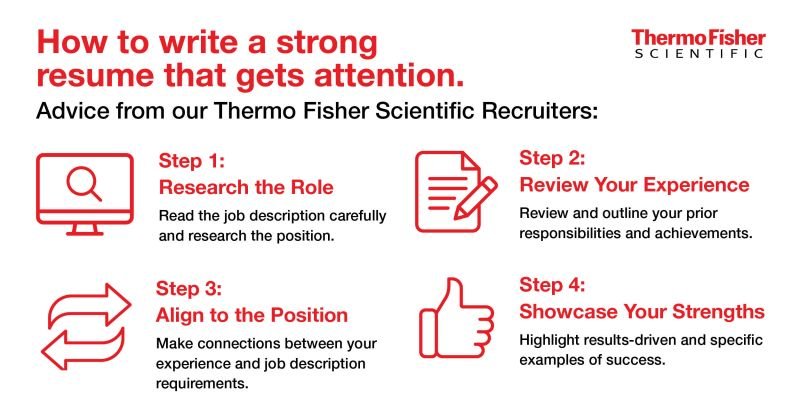Step-by-step breakdown: How to write a strong resume
30 September 2021 | Thursday | Opinion

One of the most important elements in your job search process is your resume. You have one page (sometimes two pages) to convince a recruiter why you’ll be worth the time to interview.
Our recruiters at Thermo Fisher Scientific breakdown a step-by-step approach to creating an impactful resume and increase your chances of landing an interview. The key is to show exactly what you can do and communicate it in a way that aligns well to the needs and requirements of the job and company you are interested in.
Prepare your resume
Step 1: Understand the skills, experience and qualities needed for the role.
Put yourself into the mindset of the recruiter or hiring manager. What are they looking for in their ideal candidate?
- Based on the job responsibilities, what kind of experience do you think you need to have? What kind of outcomes and results will be expected in this role?
- What educational qualifications are needed?
- What skills and proficiency levels are they looking for?
- What type of personality would do well in the role? What traits do they want applicants to have?
You can find out the answers to these questions by looking at the job description and doing some research on the position.
Tip: Search LinkedIn for employees in a similar position at the company. See how they describe their roles and responsibilities as well as their skills and background. This can give you more insight as to what the company looks for when hiring. However, not every profile you come across will be updated or optimised for a reader. So treat any information you find as inspiration, instead of prescription.
Take time to research the company through its website, social media profiles (Instagram, LinkedIn, Facebook, Glassdoor, etc.) to gain more context for the role:
- What products/services do they offer? In what markets?
- What type of clients do they serve?
- Who are their competitors?
- What are the company’s priorities for the year ahead?
Step 2: Outline what you can offer
It can be quite overwhelming to start with a blank document when writing your resume. Start by going over your past education and work experiences and list down what your goals and responsibilities were on a daily, monthly and quarterly basis in various roles. This information makes up the basic building blocks to your resume.
Step 3: Highlight the ways you are a good fit for a role.
When the company reviews your resume and application, they are basically playing a simple matching game: Does what you say in your resume match what they are looking for in the job description? If you can convince them that you sufficiently match what they need, you’ll likely be invited for an interview.
Look at the job description and do some research on the position. Use the same words and phrases found in the job description. Highlight your strengths, skills and experiences - particularly in the areas that seem to be critical for success in the role.
For example: If a role is looking for somebody with prior experience in web development using ReactJS, you can note down that you have experience with “End-to-end web development using the MERN stack – MongoDB, Express.js, ReactJS, Node.js”.
Make sure you use the same words and phrases that were used in the job description. Make it easy for a recruiter scanning your resume to pick up keywords. This will also help advance your resume through an Applicant Tracking System (ATS), the system that automatically scans your resume for keywords when you submit an application (more on this at the end of the article).
If you have limited work experience, think about any school or side projects that demonstrate your competencies. Even better, list them out in a “Personal Projects” section on your resume. Remember to include the skills and proficiencies you used in each project and any links to a Google Drive or cloud folder where the recruiters can easily access your projects.
Even for the personality traits that the company is looking for, leverage concrete examples to demonstrate these traits.
For example, the role requires a “team player”. Highlight all the times you've worked together with other people and successfully achieved a goal. An example could be: Collaborated with 5 other employees to devise and run a campaign that brought in an additional $1M annual revenue.
Bottom line: Make all these connections really clear for each role you apply to. It's more time-consuming, but it'll be so much more effective than sending out tons of generic resumes.
A common theme you may have noticed here is to include key, relevant achievements wherever possible (and truthful).
Step 4: Re-frame your resume to focus on your accomplishments.
Recruiters don't want to know what you were responsible for at your past job(s) – they want to know what you were able to accomplish. They’re more interested in results you achieved, rather than the effort you put in. When you’re deciding what to add to, keep, or remove from your resume – especially when you’re trying to keep it to one page – always favour concrete and quantifiable results.
For example, take something like:
- Oversaw and managed paperwork for internal HR processes.
This is the kind of information that doesn’t easily impress and gets forgotten because it doesn’t help the recruiter understand whether you did a good job at the task. You should include statements like these, instead:
- Revamped HR processes to reduce paperwork and improve efficiency by 15%.
Recruiters can clearly see how effective you were at your previous role(s) and will be more confident to set up as interview with you.
Step 5: Ensure your resume is free of any mistakes and inconsistencies.
It’s human to make mistakes. But where your resume is concerned, you probably shouldn’t.
Even the tiniest errors on your resume can make a negative impact on your application. They make you look sloppy – especially if the role requires attention to detail.
Before you hit 'submit' on your next application, spend some time to check your resume for:
1) Grammar and spelling mistakes
A great way to catch these mistakes is to simply read your resume out loud, word for word. That forces you to zoom in on each word you read - making it easier to catch any grammar or spelling mistakes that may have gone unnoticed.
While you’re at it, pay extra attention to ensuring any company and/or contact names in your resume are error-free.
2) Formatting errors
Observe how your resume looks overall, and then dive into the nitty-gritty. Do you spot any inconsistent line spacing? Misaligned paragraphs? Empty bullet points? You’ll want to deal with all these errors to elevate your resume into a document that’s not just clean, but consistent overall.
Tip: Use a fresh pair of eyes! Share your resume with a friend and get him/her to spot any mistakes you might have missed. If you’ve got any particularly detail-oriented friends, even better – enlist their help, and get them to review your resume from top to bottom.
And a final note: Leave your photo out.
Photos are great to have on your social media profiles, but not on your resume. In most cases, there's no real benefit to including one - it won't always enhance your chances of getting noticed and hired. Here are some good reasons to leave them out completely.
It can be used to discriminate.
Recruiters are generally careful not to be biased or discriminatory when reviewing candidates. That being said, it does happen sometimes. And having a photo on your resume increases the likelihood that you'll be discriminated against on the basis of looks, race, age, gender, or other physical factors.
Take the focus off of your appearance. Let potential employers focus on your skills and experiences.
They are not ATS-friendly.
Applicant Tracking Systems (ATS) can effectively process text, but not images. On the recruiter’s end, your photo will very likely show up as an unintelligible mess of characters or end up just getting omitted completely.
In cases like these, 1 of 2 things can happen. Either the recruiter will take the time to download and open up your resume – or just move on to the next candidate to save time. You definitely don’t want the latter happening, especially if you’ve already put in so much work to customize your resume.
Most Read
- How Health Systems Are Reshaping Drug Adoption, Partner Models, and Market Access in 2026
- Top 25 Biotech Innovations Redefining Health And Planet In 2025
- The New AI Gold Rush: Western Pharma’s Billion-Dollar Bet on Chinese Biotech
- Top 25 Biotech & Biopharma Leaders in Sustainable Innovation, 2025
- China’s Biopharma Dealmaking Surges in H1 2025, Driven by Record Licensing and Oncology Focus
- Chikungunya in China: How a “Forgotten” Arbovirus Found the Perfect Storm
- How Innovation Gaps in Biopharma Raise New Safety Concerns
- Smart Implants and the Future of Musculoskeletal Injury Treatment
- How Ethical Gaps in Psychiatry Could Undermine Biopharma Progress
- The Evolving Landscape of Women’s Health Innovation in the Asia-Pacific
- Using NLP-Driven Decision Support in Emergency Health Assistance
- Taiwan Steps Into the Global Spotlight With a New Cancer Therapy
- The Role of Unique Device Identification (UDI) in Tracing Medical Device Safety
- The Importance of a Patient’s Mental Health During Clinical Trials
Bio Jobs
- The State of Biotech and Life Science Jobs in Asia Pacific – 2025
- Avantor’s New CEO Ligner Aims to Unlock Global Potential and Deliver Shareholder Value
- AstraZeneca Commits $50 Billion to U.S. Expansion by 2030 in Biggest-Ever Global Investment
- Thermo Fisher, SAMRC, and South Africa’s Department of Science and Innovation Launch CATIR to Nurture Next-Gen Scientists
- Cube Biotech Appoints Former Sartorius CEO Dr. Joachim Kreuzburg to Board of Directors
- FDA’s AI Transition Marks a Turning Point in Drug Review: Industry Faces Pressure to Adapt Amid 20% Workforce Cut
- WuXi XDC Completes Mechanical Build of Singapore Bioconjugate Manufacturing Hub
News
Editor Picks











